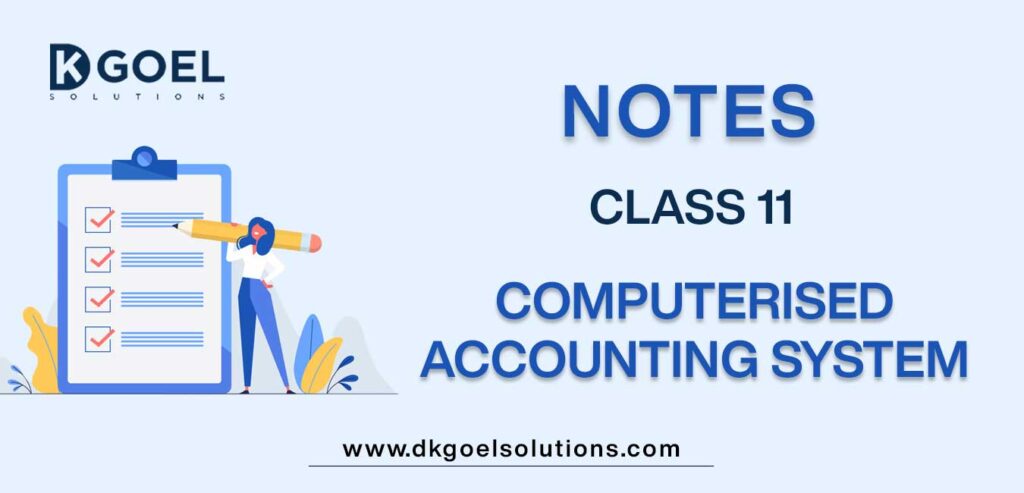Notes for Class 11 Accountancy Chapter 13 Computerised Accounting System
Students can refer to Notes for Class 11 Accountancy Chapter 13 Computerised Accounting System I given below. These notes have been prepared keeping into consideration the latest syllabus and examination guidelines issued by CBSE and NCERT. Class 11 Chapter 13 Computerised Accounting System I Notes is important to understand the topic and solve all questions given in DK Goel Class 11 Textbook
Unit at a Glance : –
• Meaning of Computer
• Components of a Computer
• MIS & AIS
• Advantages of Computerized AIS
• Limitations of Computerized AIS
• Role of Computers in Accounting
• Customized & Readymade Software
• Database & DBMS
• Structured Query Language
• Practice Questions
According to International Standards Organization –
“ A Computer is a data processor that can perform substantial computations, including numerous arithmetic & logical operations, with intervention by a human operator during the run.”
Components of a Computer
1. Input Devices : Such as Keyboard, Mouse etc.
2. CPU: It has three components – The control unit, memory unit and the logical unit.
3. Output Devices: Such As Monitor, Printer.
4. Hardware & Software
The System Software such as MS DOS, Windows 7 etc.- are a set of programs which control the operations & help processing.
The Application software such as MS Word, Tally etc. enables the user to perform useful specific functions.
Management Information System (MIS): Is an information system that provides the needed information to the managers to manage the organization effectively. It combines the three resources viz; technology, information & people for the efficient management of an enterprise.
Accounting Information System (AIS): Is an information system based on the accounting database of an organization, helping in storage, processing, summarizing & reporting information about an organization.
It has 3 elements viz: Computerized Accounting, Information and System.
Advantages of Computerized AIS :
1. High Speed : of recording, storage, processing & retrieval of information.
2. Accuracy : As all the calculations etc. are done by the computer it has accuracy.
3. Reliability : The information is reliable.
4. Real Time User Interface : AIS enables direct & simultaneous interaction between user & the machine.
Limitations of Computerized AIS :
1. Staff Opposition : As it reduces the no of employees, staff usually opposes it.
2. High Development Costs : Development requires qualified engineering staff & training also, so it’s a costly affair.
3. Security Considerations : Cyber crime & hacking etc. are becoming very common these days, therefore security is always a concern.
4. High costs makes it suitable only for medium & large sized firms & not for small firms.
Role of Computers in Accounting
Owing to Globalization the business operations are becoming large scale & complex. The need therefore arose to record, compile, summarize & present the accounting information to the large number of interested users with greater speed, accuracy & utility.
Thus computerized accounting is the only appropriate solution to these needs.
Computerized accounting serves this purpose by using both the AIS & MIS very effectively by combining the following
1. Customer Relationship Management (CRM)
2. Debtors Management
3. Inventory Management
4. Supply Chain Management
5. Payroll Accounting
6. Enterprise Resource Planning (ERP)
7. Enterprise Performance Management (EPM)
8. Computerized preparation of Financial Statements
9. Tax Planning & Management
10. Sales & Marketing Management
Comparision between Customized & Readymade Software Packages

Database & Database Management System
Database is data bank storing voluminous information about the entities within an organization and also the entities interacting with the organization.
Database Management System is the electronic data processing of information stored in the database. DBMS is “a set of programs that controls and manages creation, utilization and maintenance of database of a business organization.”
Components of Database System :
• Data
• Hardware
• Software
• Users
Advantages of DBMS :
1. Reduced Data Redundancy
2. Protection of information
3. Greater Consistency
4. Reduced Costs
5. Back-up & Recovery facility
Limitations of DBMS:
1. High setting up costs
2. Lack of Expertise Knowledge
3. Security Problems
4. Hardware & Software costs due to fast obsolescence
Structured Query Language
It is a 4th generation Computer Programming language which greatly facilitates the writing of a program or application by the programmer in one tenth of time taken in older & third generation language like COBOL.
Practice Questions
1. Explain the components of a Computer.
2. What is a computer?
3. What is MIS?
4. What is AIS?
5. What are the advantages of AIS?
6. Which of the two is better – Ready-made Accounting Software or Customized Accounting Software? Give reasons in support of your answer.
7. What is database?
8. What is DBMS?
9. What is the role of computers in accounting?
10. What is the difference between Manual & Computerized Accounting system.
11. What is SQL ? (Structured Query Language)

